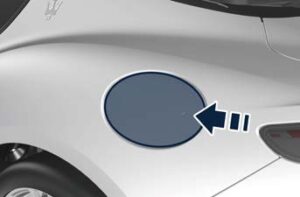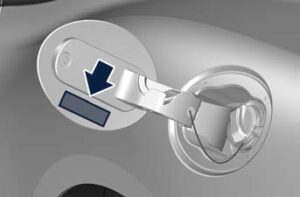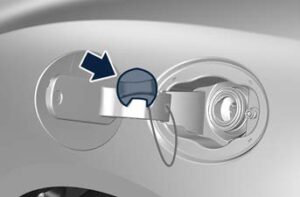Maserati GranTurismo 2024 Refueling User Manual
Introduction
The fuel tank on the Maserati GranTurismo 2024 is conveniently located for refueling. The GranTurismo provides its owners with a quick and easy refueling experience thanks to its sporty design and premium construction.
- Find the fuel filler door: The vehicle’s fuel filler door is typically found on the side, close to the rear wheel arch.
- Open the fuel filler door: To open the fuel filler door, depress the release lever or button either inside the car or on the door itself.
- Remove the fuel cap: To remove the fuel cap from the fuel filler neck, turn the fuel cap counterclockwise. Put the fuel cap somewhere tidy and safe. The fuel nozzle should now be inserted into the fuel filler neck. Make sure it is inserted securely and with proper alignment.
- Refuel the vehicle: Select the desired fuel grade and begin refueling by following the instructions on the fuel dispenser. Avoid overfilling the tank and stop refilling it once it is full.
- Put the fuel cap back on: After refueling, screw the fuel cap firmly onto the fuel filler neck. Make sure it is properly tightened to avoid fuel leaks.
- Close the fuel filler door: Firmly latch the fuel filler door after gently closing it.
The Maserati GranTurismo 2024 refueling procedure can be made a routine part of owning and enjoying this exceptional luxury sports car by following these easy steps and abiding by safety regulations.
Refueling
Fuel Filler Neck Access
To access the fuel filler neck, the filler door must be unlocked. From outside the vehicle, this can only be done by pressing the unlock or the lock button on the key fob, in the same way as if opening or closing the doors. If any of the door lock controls is pressed from inside the vehicle, the filler door will still remain closed.
- Press the indicated area on the filler door, which is located on the rear left side of the vehicle: the filler door will open completely.
NOTE:
In order to guarantee an easy fuel filler door opening, it has to be pressed in the middle right side; if pressed in any other position, it could remain locked.
Fuel Compatible Labels
To help the user in the choice of fuel compatible for the car, inside the fuel filler door is present a label shown in the picture.

NOTE:
In order to guarantee an easy fuel filler door opening, it has to be pressed in the middle right side; if pressed in any other position, it could remain locked.
Fuel Compatible Labels
To help the user in the choice of fuel compatible for the car, inside the fuel filler door is present a label shown in the picture.

The label includes two graphic symbols that identifies the type of fuel to be used compliant to EN16942 and reported in the following table.
 |
Unleaded fuel containing up to 2,7% (m/m) oxygen and a maximum ethanol content of 5,0% (V/V) EN228 com- pliant fuel |
 |
Unleaded fuel containing up to 3,7% (m/m) oxygen and a maximum ethanol content of 10,0% (V/V) EN228 compliant fuel |
Refill the Tank
The fuel filler neck is provided with external cap.
- Rotate counterclockwise and remove the fuel filler cap. The cap hermetic seal may result in a slight pressure increase inside the tank. Any hissing noise while the cap is being opened is therefore completely normal. The cap is linked to the filler neck with a strap, to prevent it from being lost while refueling.

- When refueling, place the cap in the proper seat on the filler door hinge.

- Insert the fuel nozzle fully into the filler.
WARNING!
- To avoid the risk of fire, do not approach the filler with open flames or cigarettes!
To avoid the risk of inhaling noxious fumes, do not breathe close to the fuel filler door, when opened.
Never have any smoking materials lit in or near the vehicle when the fuel filler door is open or the tank is being filled.
Never add fuel when the engine is running. This violates most fire-prevention regulations and may cause the Malfunction Indicator Light (MIL) to turn on (see “Warning and Indicator Lights” in section “Dashboard Instruments and Controls”). - Fill the vehicle with fuel (see chapter “Refilling Table in section Technical Specifications”). When the fuel nozzle “clicks” or shuts off, the fuel tank is basically full: it is possible to further ensure refueling by enabling the fuel nozzle additional fuel supply until twofold clicks. After the two additional clicks, the amount of fuel allowed by the system is very low, we recommend therefore not to persist further.
- Wait approximately 10 seconds before removing the fuel nozzle in order to ensure completed supply of residual fuel and restrict the risk of fouling the fuel filler door area.
Remove the fuel nozzle.
Insert the cap on the fuel filler neck.
Tighten the cap, turning it clockwise until it stops. - Close the fuel filler door.
CAUTION!
To avoid fuel spillage and overfilling, do not “top off” the fuel tank after filling.
Fuel Filler Cap Open Warning Light
 After refueling the car performs a check of the fuel filler cap and the amber warning light on the cluster display comes on if it is not correctly closed, after approximately 10 minutes also depending on driving conditions.
After refueling the car performs a check of the fuel filler cap and the amber warning light on the cluster display comes on if it is not correctly closed, after approximately 10 minutes also depending on driving conditions.
If the problem is in the fuel system, the Malfunction Indicator Light ![]() also comes on.
also comes on.
If the fuel filler cap is locked and the issue remains in the system, at the next engine start only the Malfunction Indicator Light![]() comes on. In this case, contact the Service Network.
comes on. In this case, contact the Service Network.
Emergency Fuel Filler Door Release
If you are unable to unlock the fuel filler door using the key fob, use the fuel filler door emergency release located in the boot.
- Open the boot lid (see “Open and Close the Boot Lid” in section “Before Driving”).
Lift the boot ground coverage.
Pull the release cable in the left part of the compartment moderately to avoid its possible break. It’s not possible to feel or hear the unlocking of the fuel filler door actuator. 
Then open normally the fuel filler door.
Driving Conditions
Before the Trip
Check the following at regular intervals and always before long trips:
- Tire pressure and condition;
levels of fluids and lubricants;
Conditions of the windshield wiper blades;
Clean the glass on the external lights and all other glass surfaces;
Proper operation of the warning lights and of the external lights.
CAUTION!
It is however advisable to perform these checks at least every 1000 km (600 mi) and always following the maintenance schedule reported in section “Maintenance and Care”.
Before you drive:
- Adjust seat position, steering wheel and rear-view mirrors in order to have the best driving position;
Ensure that nothing (mat covers, etc.) is obstructing the pedals movement;
Carefully arrange and secure any objects in the boot, to prevent them from moving forward in case of sudden stops;
Avoid heavy meals before a trip. A light snack helps keep your reflexes sharp. In particular, avoid drinking alcohol.
WARNING!
Beyond being prohibited by law, it is extremely dangerous to ride inside the boot or on the hood. In the event of an accident, passengers sitting here are more exposed to the risk of serious injury. Passengers must only travel seated in the vehicle seats, with the seat belts fastened. Always check that the driver and all passengers have the seat belts correctly fastened.
Safe Driving
Although the vehicle is equipped with active and passive safety devices, the driver’s conduct is always a decisive factor for road safety.
Some simple rules for travelling safely in different conditions are listed below. Some of them will probably already sound familiar but, in any case, it would be useful to read them carefully.
Driving at Night
The main guidelines to follow when driving at night are set out below.
- Drive carefully. Night conditions demand more focus and attention.
Reduce your speed, especially on roads with no streetlights.
Stop at early signs of drowsiness. Continuing to drive would be a risk for yourself and for others. Have a rest before continuing your trip - Keep the vehicle at a greater distance from vehicles in front of you than you would during the day: it is difficult to assess the speed of other vehicles when you only see the lights.
- Use the high beams only outside of densely-populated areas and when you are sure that they will not disturb other drivers.
- When another vehicle is approaching, switch from high beams (if on) to low beams.
- Keep lights and headlights clean.
- Outside of densely-populated areas, beware of animals crossing the road.
Driving in the Rain
Rain and wet roads are dangerous. On a wet road all maneuvers are more difficult since wheel grip on the road is significantly reduced. This means that the braking distances increase considerably and the road grip decreases.
Some recommendations for driving in the rain are listed below.
- Reduce your speed and keep a greater safety distance from the vehicles in front of you. High speed may result in a loss of vehicle control.
When driving on wet or slushy roads, it is possible for a wedge of water to build up between the tire and road surface. This is known as aquaplaning and may cause partial or complete loss of vehicle control and stopping ability. To reduce this possibility: slow down if the road has standing water or puddles. - Heavy rain substantially reduces visibility. In these circumstances, even during the day, turn on the low beams, to be more visible to other drivers.
Set the air conditioning and heating system controls on the demisting function, in order to avoid any visibility problem. - Periodically check the conditions of the windshield wiper blades.
In low grip conditions use “Comfort” driving mode (see chapters “Drive Mode” in this section). - Avoid driving with ESC OFF as this could possibly cause a loss of control of the vehicle.
Driving in Fog
If the fog is dense, avoid travelling if possible.
When driving in mist, blanket fog or when there is the possibility of banks of fog, please consider some advice listed below.
- Keep a moderate speed.
Even in daytime, turn on the low beams and rear fog lights. Do not use the high beams. - Remember that fog creates dampness on the asphalt and thus any type of maneuver is more difficult and braking distances are extended.
Keep a safe distance from the vehicle in front of you.
Avoid sudden changes in speed as much as possible.
Whenever possible, avoid overtaking.
If you are forced to stop the vehicle
(breakdowns, impossibility of proceeding due to poor visibility, etc.), first of all, try to stop off of the travel lane. Then turn on the hazard warning lights and, if possible, the low beams.
Sound the horn rhythmically if you hear another vehicle approaching.
CAUTION!
Be aware that rear fog lights can bother the drivers following your vehicle: when visibility is back to normal, turn off these lights.
Driving in the Mountains
Mountain roads usually have many narrow turns and curves, tunnels and steep uphill or downhill slopes: please consider some advices listed below.
- Drive at a moderate speed, avoid “cutting” corners.
When driving inside a tunnel in daylight turn on the low beams in advance; avoid high beams and be aware of the rapid brightness change. Avoid abrupt maneuvers that could be dangerous for the following vehicle. - Never coast downhill with the engine off or in neutral.
Remember that passing other vehicles when driving uphill is slower and thus requires more free distance on the road. If you are being overtaken on a hill, slow down and allow the other vehicle to pass.
Driving on Snow or Ice
Please consider some general advice for driving in these conditions, listed below.
- Maintain a very moderate speed. Fit snow socks or specific tires if the road is covered with snow, see chapter “Tires Information” in section “Understanding the Vehicle”.
- We recommend you to activate the
“Comfort” mode (see chapters “Drive Mode” in this section).
During the winter season, even apparently dry roads can have icy sections. Be careful when crossing bridges, viaducts and roads that have little exposure to the sun and are bordered by trees and rocks. They may be icy.
Keep an ample safe distance from the vehicles in front of you.
When driving on dirty roads (mud, snow or ice), clean you vehicle as described in the paragraph “Car Wash” (see chapter “Bodywork Maintenance and Care” in section “Maintenance and Care”). - Avoid sharp braking, sharp changes in direction and rapid acceleration. Rapid acceleration on snow covered or icy surfaces may cause the driving wheels to pull erratically to the right or left. This phenomenon occurs when there is a difference in the surface traction under the rear (driving) wheels.
WARNING!
Rapid acceleration on slippery surfaces is dangerous. Unequal traction can cause sudden pulling of the rear driving wheels. You could lose control of the vehicle and possibly have a collision. Accelerate slowly and carefully whenever there is likely to be poor traction (ice, snow, wet mud, loose sand, etc.).
Driving through Flooded Sections
Driving through water sections will requires extra caution to ensure passenger safety and prevent damage to your vehicle.
FAQs
- What type of fuel does the Maserati GranTurismo 2024 require?
Premium unleaded gasoline is typically required for the Maserati GranTurismo 2024. For information on the recommended fuel grade, it is advised to consult the owner’s manual or a certified Maserati dealer. - What is the fuel tank capacity of the Maserati GranTurismo 2024?
Depending on the GranTurismo’s specific model and trim level, the precise fuel tank capacity may change. For accurate information on the fuel tank capacity of a vehicle, it is advised to consult the owner’s manual or get in touch with a certified Maserati dealer. - Can I use a different fuel grade than recommended for the GranTurismo?
For optimum performance and extended engine life, it is generally advised to use the fuel grade recommended by Maserati. Performance may be impacted by using a lower-grade fuel, while using a higher-grade fuel might not offer any additional advantages. - How do I open the fuel filler door in the GranTurismo?
Look for the release lever or button inside the car or on the fuel filler door itself to open it. To open the door, push or pull on the release mechanism. - Can I refuel the GranTurismo with the engine running?
For safety purposes, it is advised to turn off the engine before refueling the GranTurismo. This lessens the possibility of accidents and fuel spills. - How do I know when the fuel tank is full during refuelling?
The majority of fuel dispensers have an automatic shut-off feature that halts the flow of fuel when the tank is full. When determining when the tank is full, pay attention to the sound and flow of the fuel and take care not to overfill. - Are there any precautions I should take while refuelling the GranTurismo?
It’s important to refrain from using electronic devices, open flames, or smoking while refueling. In order to avoid fuel leaks, make sure the fuel cap is tightly fastened after refueling. - Can I use a fuel additive in the GranTurismo?
Unless specifically recommended by an authorized Maserati dealer or mentioned in the owner’s manual, Maserati generally does not advise using fuel additives. To preserve the vehicle’s performance and warranty, it is best to adhere to the manufacturer’s recommendations. - How often should I refuel the GranTurismo?
A number of variables, such as driving habits, road conditions, and fuel efficiency, affect how often you should refuel. It is advised to keep an eye on the fuel gauge and to refuel when necessary, especially before longer trips. - Can I use biofuels or ethanol blends in the GranTurismo?
To find out if the GranTurismo is compatible with biofuels or ethanol blends, it’s important to consult the owner’s manual or speak with a licensed Maserati dealer. The vehicle’s warranty could be voided if you use fuel that the manufacturer does not recommend. - Can I refuel the GranTurismo with a diesel fuel nozzle?
The Maserati GranTurismo 2024 cannot be refueled with diesel fuel; it needs unleaded gasoline. The engine and other parts can sustain severe damage if the incorrect fuel is used. - Can I refuel the GranTurismo with a gas can or container?
While refueling the GranTurismo with a gas can or container is possible, it’s crucial to use caution and adhere to local safety regulations. Make sure the container is free of debris, clean, and properly labeled. - Is the GranTurismo equipped with any fuel-saving features?
The GranTurismo might have advanced fuel management systems, an efficient engine, aerodynamic styling, and other fuel-saving features. However, depending on the model and trim level, specific fuel-saving features might change. For more information, speak to a certified Maserati dealer or the vehicle’s owner’s manual. - Can I check the fuel level remotely or through a mobile app?
Whether you can check the fuel level remotely or via a mobile app depends on the GranTurismo’s specific features and connectivity options. You may be able to monitor certain vehicle parameters, including the fuel level, with some vehicles’ remote access or connected services. - Can I retrofit the GranTurismo with a larger fuel tank?
It might not be advised or possible to retrofit the GranTurismo with a larger fuel tank because doing so would require changes to the car’s fuel system and might impair its performance and warranty. For more details on modifications, it is advised to speak with an authorized Maserati dealer or service facility.
Useful Links
Download Manuals: On-Board Owner Documentation | Maserati
2023 Maserati Granturismo Specs, Price, Features, Mileage (Brochure)
Related Article:
2023 Maserati GRECALE Specs, Price, Features, Mileage (Brochure)
2023 Maserati Ghibli Specs, Price, Features, Mileage (Brochure)
2023 Maserati Levante Specs, Price, Features, Mileage (Brochure)
2023 Maserati Quattroporte Specs, Price, Features, Mileage (Brochure)


